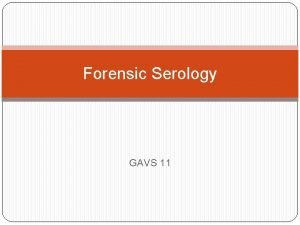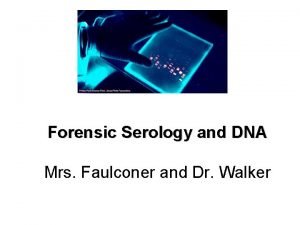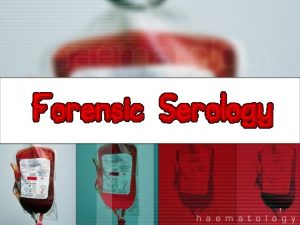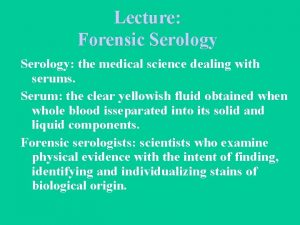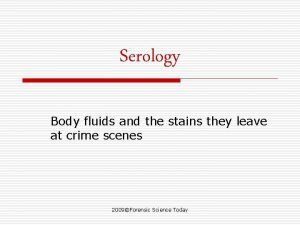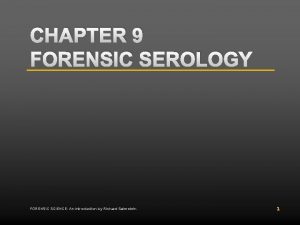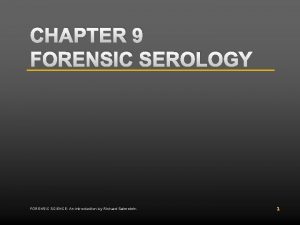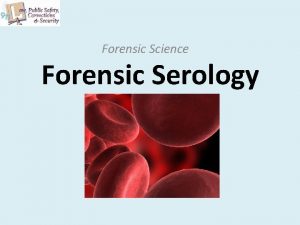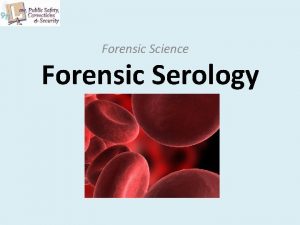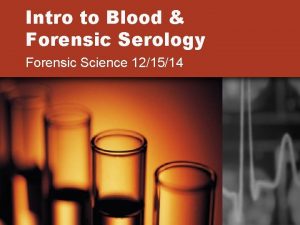Chapter 8 FORENSIC SEROLOGY FORENSIC SCIENCE An Introduction















- Slides: 15

Chapter 8 FORENSIC SEROLOGY FORENSIC SCIENCE An Introduction By Richard Saferstein PRENTICE HALL © 2008 Pearson Education, Inc. Upper Saddle River, NJ 07458 8 -1

Nature of Blood • The word blood refers to a highly complex mixture of cells, enzymes, proteins, and inorganic substances. • Plasma, which is the fluid portion of blood, is composed principally of water. • Red blood cells (erythrocytes), white blood cells (leukocytes), and platelets are the solid materials suspended in plasma. • Antigens, usually proteins, are located on the surface of red blood cells and are responsible for blood-type characteristics. FORENSIC SCIENCE An Introduction By Richard Saferstein PRENTICE HALL © 2008 Pearson Education, Inc. Upper Saddle River, NJ 07458 8 -2

Blood Typing • More than 15 blood antigen systems have been identified, but the A-B-O and Rh systems are the most important. • An individual that is type A has A antigens on his/her red blood cells, type B has B antigens, AB has both A and B antigens, and type O has neither A nor B antigens. • Rh factor is determined by the presence of another antigen, the D antigen. • People having the D antigen are Rh positive; those not having the antigen are Rh negative. • For every antigen there is a specific antibody that will react with it to form clumps known as agglutination. • Thus, if serum containing anti-B is added to red blood cells carrying B antigen, they will immediately react. FORENSIC SCIENCE An Introduction By Richard Saferstein PRENTICE HALL © 2008 Pearson Education, Inc. Upper Saddle River, NJ 07458 8 -3

Serology • The term serology is used to describe a broad scope of laboratory tests that use specific antigen and serum antibody reactions. • The identity of each of the four A-B-O blood groups can be established by testing the blood with anti-A and anti-B sera. • The concept of specific antigen–antibody reactions has been applied to immunoassay techniques for the detection of drugs of abuse in blood and urine. FORENSIC SCIENCE An Introduction By Richard Saferstein PRENTICE HALL © 2008 Pearson Education, Inc. Upper Saddle River, NJ 07458 8 -4

Immunoassay • A number of immunological assay techniques are commercially available for detecting drugs through antigen-antibody reaction. • One such technique, the enzyme-multiplied immunoassay technique (EMIT), is used by toxicologists because of its speed and high sensitivity for detecting drugs in urine. • In a typical EMIT analysis, antibodies that will bind to a specific drug are added to the subject’s urine. • Other immunoassay procedures are also available, such as radioimmunoassay (RIA), which uses drugs labeled with radioactive tags. FORENSIC SCIENCE An Introduction By Richard Saferstein PRENTICE HALL © 2008 Pearson Education, Inc. Upper Saddle River, NJ 07458 8 -5

Antigen-Antibody Reaction • When an animal, such as a rabbit or mouse, is injected with an antigen its body will produce a series of different antibodies, all of which are designed to attack some particular site on the antigen of interest. • This collection of antibodies is known as polyclonal antibodies. • Alternately, a more uniform and specific collection of antibodies designed to combine with a single antigen site can be manufactured. • Such antibodies are known as monoclonals. FORENSIC SCIENCE An Introduction By Richard Saferstein PRENTICE HALL © 2008 Pearson Education, Inc. Upper Saddle River, NJ 07458 8 -6

Forensics of Blood • The criminalist must be prepared to answer the following questions when examining dried blood: 1. Is it blood? 2. From what species did the blood originate? 3. If the blood is of human origin, how closely can it be associated to a particular individual? • The determination of blood is best made by means of a preliminary color test. FORENSIC SCIENCE An Introduction By Richard Saferstein PRENTICE HALL © 2008 Pearson Education, Inc. Upper Saddle River, NJ 07458 8 -7

The Tests • A positive result from the Kastle-Meyer color test is highly indicative of blood. – Hemoglobin causes a deep pink color. • Alternatively, the luminol test is used to search out trace amounts of blood located at crime scenes. – Produces light (luminescence) in a darkened area. • Microcrystalline tests, such as the Takayama and Teichmann tests, depend on the addition of specific chemicals to the blood so that characteristic crystals will be formed. FORENSIC SCIENCE An Introduction By Richard Saferstein PRENTICE HALL © 2008 Pearson Education, Inc. Upper Saddle River, NJ 07458 8 -8

The Tests • Once the stain has been characterized as blood, the precipitin test will determine whether the stain is of human or animal origin. • The precipitin test uses antisera normally derived from rabbits that have been injected with the blood of a known animal to determine the species origin of a questioned bloodstain. • Once it has been determined that the bloodstain is of human origin, an effort must be made to associate or dissociate the stain with a particular individual. • DNA analysis has allowed forensic scientists to associate blood to a single individual. FORENSIC SCIENCE An Introduction By Richard Saferstein PRENTICE HALL © 2008 Pearson Education, Inc. Upper Saddle River, NJ 07458 8 -9

Stain Patterns of Blood • The crime scene investigator must remember that the location, distribution, and appearance of bloodstains and spatters may be useful for interpreting and reconstructing the events that produced the bleeding. • Surface texture and the stain’s shape, size, and location must be considered when determining the direction, dropping distance, and angle of impact of a bloodstain. FORENSIC SCIENCE An Introduction By Richard Saferstein PRENTICE HALL © 2008 Pearson Education, Inc. Upper Saddle River, NJ 07458 8 -10

Stain Patterns of Blood • Surface texture is of paramount importance. In general, the harder and less porous the surface, the less spatter results. • The direction of travel of blood striking an object may be discerned because the pointed end of a bloodstain always faces its direction of travel. • The impact angle of blood on a flat surface can be determined by measuring the degree of circular distortion. At right angles the blood drop is circular, as the angle decreases, the stain becomes elongated. • The origin of a blood spatter in a two-dimensional configuration can be established by drawing straight lines through the long axis of several individual bloodstains. The intersection or point of convergence of the lines represents the origin point. FORENSIC SCIENCE An Introduction By Richard Saferstein PRENTICE HALL © 2008 Pearson Education, Inc. Upper Saddle River, NJ 07458 8 -11

Heredity and Paternity • The transmission of hereditary material is accomplished by means of microscopic units called genes, located on chromosomes. • Alternative forms of genes that influence a given characteristic (such as eye color or blood type) are known as alleles. • Paternity testing has historically involved the A-B-O blood typing system, along with blood factors other than A-B-O. • Currently, paternity testing has implemented DNA test procedures that can raise the odds of establishing paternity beyond 99 percent. FORENSIC SCIENCE An Introduction By Richard Saferstein PRENTICE HALL © 2008 Pearson Education, Inc. Upper Saddle River, NJ 07458 8 -12

Testing for Seminal Stains • Many of the cases sent to a forensic laboratory involve sexual offenses, making it necessary to examine exhibits for the presence of seminal stains. • The best way to locate and at the same time characterize a seminal stain is to perform the acid phosphatase (an enzyme secreted into seminal fluid) color test. – A purple color indicates acid phosphatase enzyme. • Semen can be unequivocally identified by either the presence of spermatozoa or of p 30, a protein unique to seminal plasma. • Forensic scientists can successfully link seminal material to an individual by DNA typing. FORENSIC SCIENCE An Introduction By Richard Saferstein PRENTICE HALL © 2008 Pearson Education, Inc. Upper Saddle River, NJ 07458 8 -13

Rape Evidence • The rape victim must undergo a medical examination as soon as possible after the assault. • At that time the appropriate items of physical evidence including clothing, hairs, and vaginal and rectal swabs can be collected for subsequent laboratory examination. • All outer and undergarments should be carefully removed and packaged separately in paper (not plastic) bags. • Bedding, or the object upon which the assault took place, may also be carefully collected. FORENSIC SCIENCE An Introduction By Richard Saferstein PRENTICE HALL © 2008 Pearson Education, Inc. Upper Saddle River, NJ 07458 8 -14

Rape Evidence • If a suspect is apprehended within 24 hours of the assault, it may be possible to detect the victim’s DNA on the male’s underwear or on a penile swab of the suspect. • Items routinely collected from the suspect include all clothing, pubic hair, head hair, penile swab, and a blood sample or buccal swab for DNA typing. • The forceful physical contact between victim and assailant may result in a transfer of such physical evidence of blood, semen, saliva, hairs, and fibers. FORENSIC SCIENCE An Introduction By Richard Saferstein PRENTICE HALL © 2008 Pearson Education, Inc. Upper Saddle River, NJ 07458 8 -15
 Cins ve tür arasındaki fark
Cins ve tür arasındaki fark Important people in forensics
Important people in forensics Forensic serology definition
Forensic serology definition Father of forensic serology
Father of forensic serology Sir arthur conan doyle contribution forensic science
Sir arthur conan doyle contribution forensic science Define forensic serology
Define forensic serology Father of forensic serology
Father of forensic serology Lwipe
Lwipe Forensic science chapter 1
Forensic science chapter 1 History of forensic science ppt
History of forensic science ppt Forensic science unit 1 review
Forensic science unit 1 review Forensic science an introduction
Forensic science an introduction Serology
Serology Ballistics and spatter lab
Ballistics and spatter lab Serology book
Serology book Serology
Serology


